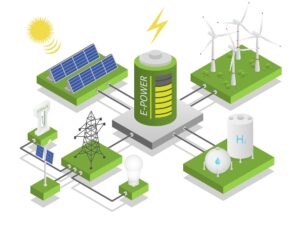Lithium Iron Phosphate (LFP) batteries have become increasingly popular due to their inherent safety, long lifespan and cost-effectiveness. But in order to compete fully against other battery chemistries such as nickel-cobalt-manganese (NCM) and emerging solid-state batteries like LFP technology must address some performance limitations, particularly energy density issues. This blog will look into advancements that could boost LFP battery performance; compare its results against NCM and solid-state alternatives; as well as discuss innovations aimed at reducing production costs.
1. Advances to Increase Energy Density and Performance in LFP Batteries
One of the primary challenges posed by LFP batteries is their lower energy density relative to other lithium-ion battery technologies such as NCM. Although LFP batteries excel in terms of safety and cost, improving energy density will enable more competitiveness in high performance electric vehicle (EV) applications as well as large scale energy storage systems (ESS).
Nanotechnology and Nano-Coatings: Nanotechnology can offer one promising approach to increasing energy density. Researchers are conducting extensive work with nano-scale modifications of iron phosphate cathodes in order to enhance conductivity, electrochemical performance, particle reduction and surface area increase for LFP batteries to increase charge/discharge rates and energy capacity. Nano-coatings or advanced cathode designs also can aid in increasing density by improving electron and ion flow within batteries.
Phosphate-Based Composite Materials: Another area of development involves using phosphate-based composite materials as cathode material. Combining LFP with carbon, graphene or other conductive additives can enhance battery conductivity and capacity retention, leading to enhanced performance – leading companies like BYD and CATL to explore such composites to increase LFP battery performance without significantly impacting cost.
Improved Battery Management Systems (BMS): To ensure safe and effective LFP battery use, an advanced Battery Management System (BMS) is essential. Utilizing advanced algorithms that track cell conditions, temperature fluctuations, charge/discharge cycles and life extension of LFP batteries; BMS technologies often employ artificial intelligence (AI) capabilities that predict battery health to further increase their overall performance and extend lifespan.
2. Comparing LFP Batteries to NCM and Solid-State Batteries
While LFP batteries have become a widely utilized choice in applications like electric vehicles (EVs) and energy storage, it is critical to assess their performance against NCM (nickel-cobalt-manganese) batteries as well as emerging solid-state options in order to determine where LFP stands in the market.
Energy Density: LFP batteries typically offer lower energy densities compared to NCM batteries; LFP typically offers between 140-160 Wh/kg while NCM can reach 200-250 Wh/kg or even beyond, which makes a significant difference when driving distance needs are a priority. As such, these differences make an LFP battery the better choice in affordable EV models while high performance vehicles where energy density plays a more essential role use NCM cells instead.
Safety and Thermal Stability: LFP batteries offer key advantages over their NCM counterparts when it comes to safety and thermal stability, such as being less likely to overheat or catch fire – something NCM batteries, while more energy dense, are more prone to thermal runaway, which could potentially pose fire hazards if left unmanaged.
Cycle Life: LFP batteries typically offer more than 4,000 charge cycles, outstripping NCM batteries which typically only offer 1,000-1,500 cycles. Their longer cycle life makes LFP batteries ideal for energy storage systems (ESS), where longevity is key.
Cost: LFP batteries are more cost-effective than NCM batteries due to not requiring expensive metals like cobalt and nickel for manufacturing. This cost advantage has led to their rapid adoption in lower cost EVs and stationary storage systems.
Solid-State Batteries (SSBs) are considered an innovative advancement of battery technology, boasting even higher energy density and superior safety profiles than both LFP and NCM batteries. In theory, solid state batteries could double current lithium-ion energy densities while remaining safer due to their absence of liquid electrolytes; however, development work for this technology remains ongoing due to issues related to scaleability, manufacturing costs, material durability and material scalability.
3. Innovations to Reduce LFP Battery Production Costs
Reducing production costs is crucial to expanding LFP battery use within EV and ESS markets, as demand grows exponentially. Numerous initiatives are underway in order to lower manufacturing costs while upholding performance and safety advantages associated with these batteries.
Simplified Production Processes: One significant advancement is the streamlining of production. Traditional LFP batteries involve complex steps for synthesizing cathode materials, which can be costly. New techniques, including direct charging techniques and efficient iron ore synthesis using lower grades, are being created to decrease costs by using lesser purity materials for production and manufacturing costs.
Automation and Scale-Up: Automation in battery manufacturing has played a critical role in cutting costs. As mass production ramps up rapidly, manufacturers are investing in automation technologies like robotic assembly lines, AI-powered quality control, modular production systems and modular production lines to increase production speed and consistency while simultaneously decreasing per unit costs of LFP batteries.
Recyclability and Reuse of Materials: Recycling can also provide cost reductions, especially since LFP batteries utilise abundant and affordable materials like iron and phosphate, which are easier to recycle compared to other battery chemistries. Furthermore, advances in recycling technology like closed-loop recycling or second life applications could further bring down raw material costs, making LFP batteries more economically priced.
Integration of New Additives and Materials: Researchers are also exploring alternative additives and cost-effective materials as potential replacements for expensive cobalt. For instance, companies are testing lithium content reduction or graphene composites which could lower manufacturing costs without impacting battery performance.
Conclusion
LFP batteries are well positioned for continued growth due to key advancements in energy density, safety and cost reduction that enhance their competitiveness in the global battery market. While LFP currently lags behind NCM in energy density terms, its advantages in cost, safety and longevity make it a superior option for mass market electric vehicles and energy storage systems alike. With continuous innovation taking place within nanotechnology production processes and recycling initiatives – LFP batteries stand to play an increasingly significant role in driving energy transition forward.





